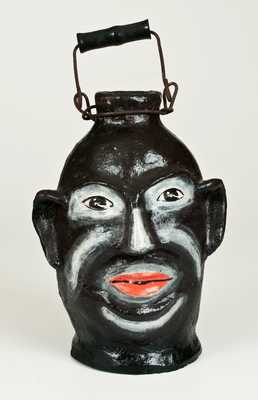Extremely Rare and Important Alkaline-Glazed Stoneware Ring Jug with Glass Runs and "Lassoed" Spout, Stamped "J.S. NASH," attributed to Milligan Frazier at the Jefferson S. Nash shop, Marion County, TX, circa 1865, ring-form jug with pedestal base, tall spout with tooled accents, and applied strap handle. The artistic and highly unusual addition of an applied ring of clay seemingly clamps the upper end of the handle around the base of the spout in a "lassoed" configuration. Surface covered in a mottled brown alkaline glaze with visually-appealing clear glaze runs throughout. Shoulder impressed "J.S. NASH" for Jefferson S. Nash, an Edgfield, SC-trained potter who established a shop in Marion County, Texas, during the middle of the 19th century. This jug bears the distinctive glaze of Milligan Frazier, an African-American slave in Nash's employ. Other examples with a dark-brown alkaline glaze accented with glass runs have born strong Frazier attributions. The February 17, 1974 edition of The Longview Morning Journal, a Texas newspaper, contains an article on Frazier and his pottery. According to this article, Frazier was eventually producing ware independently at his homestead near the Nash site, known as "Milligan's Jug Works". Glass used to produce the glazes were acquired from local townspeople in the form of "old bottles, snuff jars, and blue glass bottles". The glazing process is described as follows: "First he would grind the glass into a fine powder, then mix it with powdered sand rock and water until it was like paint, then roll the pottery piece in the mixture. This finished, he would sprinkle finely ground white glass over the rim and rop, thus resulting in a variance of color after the pieces were baked. Browns of varying shades, streaked with black, seemed to be the dominant colors for his works". Frazier's son, Sam, who was alive at the writing of this article and active at his father's shop in the early 20th century, provided this detailed information. Few signed examples of Nash pottery have survived, and this jug is the only example of the form produced at Nash's shop we are aware of. Its skillful potting, fine glazing, and attribution to a well-documented African-American potter, contribute to its importance in the genre of Southern folk pottery. Provenance: A fresh-to-the-market example, which descended in a Florida family. Small base chips. A small chip to spout. A minor nick to raised spout molding. H 9 1/2".










